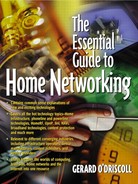SHARING A BROADBAND INTERNET CONNECTION
Convergence between home networks and the Internet is providing a revolution in home entertainment. Through this phenomenon, physical walls within a home are slowly being opened up with virtual windows that bring entertainment into any and all rooms within the house.
Today, most members of a family would like to have access to the Internet without the constraints associated with installing and running separate telephone lines. Home networks can deliver significant savings and greater family entertainment value by allowing all family members to share a common high-speed Internet connection.
To address the issue of sharing an Internet connection, a number of vendors have developed tools that allow multiple devices in the home to share a single broadband Internet connection. Rather than giving you a brief description of each of these tools, we decided to present a detailed overview of a software program developed by Microsoft called Microsoft Internet Connection Sharing (MICS). The MICS service runs on a home server that is connected to a broadband Internet connection. The MICS tool consists of three separate components.
Network Address Table (NAT)— The NAT allows multiple digital appliances on a home network to share the IP address that was allocated to the home server by the DHCP server on the broadband network.
DHCP address allocator— The address allocator is a DHCP mechanism used to dynamically assign a private IP address to each appliance and PC on a home network. For instance, if the home server receives the address 10.16.0.1 from the broadband DHCP server, the ICS service will then assign an IP address to each device on the home network by using a subnet mask (i.e., 255.255.220.0). The allocator can be disabled if you decide to use static addresses.
DNS service— The DNS service allows PCs and A/V devices on the home network to query a DNS server on the broadband network. A service provider normally uses a DNS server to store domain names and IP addresses that have been allocated to devices on an in-home network. The home server running the MICS program will simply forward the requests to the external server.
